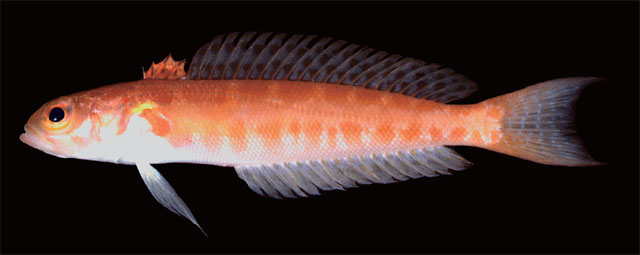|
Dorsal spines (total): 5-6; Dorsal soft rays (total): 22-22; Anal spines: 1-1; Anal soft rays: 18-18; Vertebrae: 30-30. This species is distinguished by the following characters: D V, 22 (one with VI); A I, 18; pectoral-fin rays 17 or 18 (usually 17); lateral-line scales 59-61; median predorsal scales 10-11; gill rakers 3-5+10-13; projecting lower jaw; canine teeth 3 pairs anteriorly in lower jaw; palatine teeth absent; vomer has a row of 10-14 small conical teeth; body scales finely ctenoid, becoming cycloid ventrally on abdomen, prepelvic area, nape, and below spinous portion of dorsal fin; above posterior margin of preopercle at level of dorsal edge of orbit is an isolated round patch of small cycloid scales; opercle and cheek with small, cycloid and partially embedded scales; preopercle with smooth margin; body depth 5.0-6.1 in SL; head length 3.3-3.6 in SL; snout length 3.65-4.5 in HL; orbit diameter 3.1-3.4 in HL; very broad interorbital space, 3.35-4.4 in HL; third or fourth dorsal spine longest, 3.25-3.65 in HL; caudal fin in females emarginate, in males lunate; pectoral fins slightly emarginate, 4.2-4.7 in SL; pelvic fins reaching or slightly extending posterior to origin of anal fin, 3.8-4.75 in SL. Preserved color of males pale yellowish with a slightly oblique, broad, purplish gray bar anteriorly on body, bordered by a pale bar and a narrow purplish gray bar; in females pale yellowish; base of membranes of spinous portion of dorsal fin dark brown. Color in life of males red to violet-red dorsally, grading to lavender-pink ventrally, a yellow bar beneath anterior fourth of soft portion of dorsal fin, bordered by a pale-edged bright red bar; spinous portion of dorsal fin orange-red, many yellow spots on the soft portion; caudal fin with deep red lobes; axil of pectoral fins with a bright red spot at the base and; in females light red dorsally on body with 10 darker red bars on about upper one-fourth that are narrower posteriorly; 14 orangish pink bars of unequal width on lower side of body; spinous portion of dorsal fin is bright orange-red, deep red to blackish at base except last membrane white; soft portion of dorsal fin with numerous red spots; caudal fin lobes red; base and axil of pectoral fins in a bright red spot bordered by white; juveniles has a narrow orange stripe, bordered by white, from behind eye to upper base of caudal fin, the anterior third showing paler lateral line; ventral half of body pink; spinous portion of dorsal fin red with a black spot near base of membranes, except white first and last membranes; soft portion of fin translucent with many dark reddish brown spots (Ref. 75205). |

